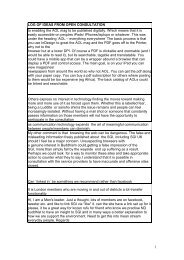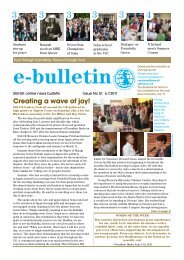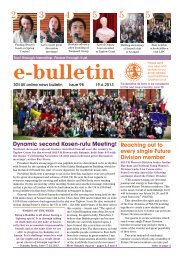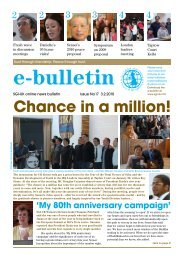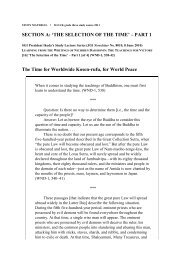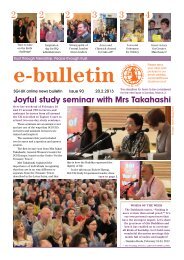Cause and Effect and the 9 Consciousnesses.pdf
Cause and Effect and the 9 Consciousnesses.pdf
Cause and Effect and the 9 Consciousnesses.pdf
Create successful ePaper yourself
Turn your PDF publications into a flip-book with our unique Google optimized e-Paper software.
CAUSE<br />
AND EFFECT<br />
AND THE NINE<br />
CONSCIOUSNESSES<br />
<strong>Cause</strong> <strong>and</strong> effect<br />
As we go about our daily<br />
lives, in every single moment, we<br />
make causes in <strong>the</strong> things that we think<br />
<strong>and</strong> say <strong>and</strong> do. Buddhism teaches <strong>the</strong><br />
existence of a law of cause <strong>and</strong> effect<br />
which explains that when we make a<br />
cause, <strong>the</strong> anticipated<br />
effect of that cause is stored deep in<br />
our lives, <strong>and</strong> when <strong>the</strong> right<br />
circumstances appear <strong>the</strong>n we<br />
experience <strong>the</strong> effect. This concept of<br />
cause <strong>and</strong> effect is at <strong>the</strong> heart of<br />
Buddhism, <strong>and</strong> <strong>the</strong> characters for<br />
'renge' in Nam-myoho-renge-kyo mean<br />
<strong>the</strong> simultaneity of <strong>the</strong> internal cause<br />
<strong>and</strong> <strong>the</strong> internal effect. This means<br />
that, through chanting, we have made<br />
<strong>the</strong> cause for our Buddhahood, <strong>and</strong> <strong>the</strong><br />
effect of it exists simultaneously with<br />
that cause. By chanting we are directly<br />
causing our Buddhahood to appear.<br />
Renge literally means 'lotus<br />
flower', which is a beautiful plant that<br />
floats on <strong>the</strong> surface of water <strong>and</strong> its<br />
beauty is nourished through its roots in<br />
<strong>the</strong> mud. This is a metaphor for our<br />
lives. Chanting Nam-myoho-renge-kyo<br />
uses <strong>the</strong> `mud` in our lives to enable us<br />
to reveal our highest life state.<br />
But <strong>the</strong> Lotus flower is<br />
significant for a second reason. It is a<br />
plant that flowers <strong>and</strong> seeds at <strong>the</strong><br />
same time. It beautifully illustrates <strong>the</strong><br />
profound working of life where <strong>the</strong><br />
effect is simultaneous with <strong>the</strong> cause.<br />
An example of <strong>the</strong> way<br />
Buddhism views cause <strong>and</strong> effect<br />
might be of a young person going<br />
home to spend a weekend with <strong>the</strong>ir<br />
parents. They have a blazing row<br />
before <strong>the</strong> end of <strong>the</strong> weekend <strong>and</strong> <strong>the</strong><br />
young person leaves. In Western<br />
society we tend to see <strong>the</strong> blazing row<br />
as <strong>the</strong> cause <strong>and</strong> <strong>the</strong> young person<br />
leaving <strong>the</strong> effect. But Buddhism<br />
SGI-UK Study Department<br />
Introductory Study Programme<br />
focuses attention on <strong>the</strong> internal cause<br />
<strong>and</strong> effect. So it may be that <strong>the</strong><br />
internal cause turns out to be that <strong>the</strong><br />
young person disrespects <strong>the</strong>ir parents,<br />
at quite a deep level, perhaps without<br />
realising it. The effect which is<br />
simultaneous with this cause is <strong>the</strong><br />
state of hell, <strong>and</strong> it is this that is<br />
triggering <strong>the</strong> arguing. This example<br />
could equally be <strong>the</strong> o<strong>the</strong>r way round,<br />
with <strong>the</strong> parents doing <strong>the</strong><br />
disrespecting. It is <strong>the</strong> internal cause<br />
<strong>and</strong> effect which a person who chants<br />
Nam-myoho-renge-kyo can change,<br />
replacing <strong>the</strong>ir internal feelings with<br />
respect.<br />
Through <strong>the</strong> simultaneity of<br />
cause <strong>and</strong> effect we can cause our<br />
Buddhahood to appear. To help us<br />
gain a clearer underst<strong>and</strong>ing of what<br />
Nam-myoho-renge-kyo is we need to<br />
appreciate <strong>the</strong> nine consciousnesses.<br />
The nine consciousnesses can be<br />
thought of as different layers of<br />
consciousness which are constantly<br />
operating toge<strong>the</strong>r to create our lives.<br />
And as we progress through<br />
explanations of <strong>the</strong>se consciousnesses<br />
<strong>the</strong> significance of <strong>the</strong> principle of <strong>the</strong><br />
simultaneity of cause <strong>and</strong> effect should<br />
become apparent.<br />
The nine<br />
consciousnesses<br />
The first five<br />
`consciousnesses' are our basic senses<br />
of sight, hearing, touch, smell <strong>and</strong><br />
taste, which we use to take in<br />
information from outside ourselves in<br />
order to underst<strong>and</strong> what is going on<br />
in <strong>the</strong> world. Imagine <strong>the</strong> moment of<br />
birth. The baby, at that moment<br />
is aware of sound, of smell, touch,<br />
taste, <strong>and</strong> sight. Like <strong>the</strong> baby we<br />
become attached to <strong>the</strong> world to such a<br />
degree that, for many, <strong>the</strong> world in all<br />
its complexities continues to hold our<br />
attention <strong>and</strong> we remain ignorant of<br />
<strong>the</strong> working of <strong>the</strong> deeper `layers` of<br />
consciousness.<br />
Eventually <strong>the</strong> baby grows<br />
<strong>and</strong> learns that what it is seeing is, say<br />
`blue` or what it is feeling is `hot`.<br />
This is <strong>the</strong> sixth consciousness<br />
or <strong>the</strong> mind as we are used to thinking<br />
of it, which functions to enable us to<br />
make sense of what is coming to us<br />
through our senses. It is primarily<br />
through <strong>the</strong> interaction of <strong>the</strong>se first 6<br />
consciousnesses that we perform our<br />
daily activities.<br />
The seventh consciousness is<br />
directed towards our inner, spiritual<br />
world. It is in <strong>the</strong> 7 th consciousness<br />
that <strong>the</strong> conditioning we experience as<br />
we grow up is stored. It is through this<br />
consciousness that we have our sense<br />
of who we are, our gender, our<br />
national identity <strong>and</strong> so on.<br />
Attachment to a self distinct <strong>and</strong><br />
separate from o<strong>the</strong>rs has its basis in<br />
this consciousness as does our sense of<br />
right <strong>and</strong> wrong. We might see <strong>the</strong><br />
appearance of various <strong>the</strong>rapies <strong>and</strong><br />
counselling in <strong>the</strong> West as a response<br />
to <strong>the</strong> desire on <strong>the</strong> part of many to<br />
free <strong>the</strong>mselves from some of <strong>the</strong><br />
conditioning that has taken place in<br />
life <strong>and</strong> which is stored in <strong>the</strong> 7 th<br />
consciousness.<br />
Western culture really only<br />
has an underst<strong>and</strong>ing of <strong>the</strong> first 7<br />
consciousnesses. The concept of an<br />
eighth consciousness storing all our<br />
internal causes <strong>and</strong> internal effects<br />
(our karma) is generally not in use in<br />
daily life. And <strong>the</strong> concept of a ninth<br />
consciousness being <strong>the</strong> fundamental<br />
workings of life itself throughout <strong>the</strong><br />
universe is definitely not part of our<br />
culture! The ninth consciousness in<br />
Buddhism is Nam-myoho-renge-kyo<br />
or <strong>the</strong> Law of life.<br />
1 to 5 touch, taste, sight, hearing,<br />
smell<br />
6 conscious mind<br />
7 sub conscious/limited egoistic<br />
self<br />
8 karma<br />
9 Law of life<br />
The eighth <strong>and</strong> ninth<br />
consciousnesses are operating at <strong>the</strong><br />
level of <strong>the</strong> fundamental<br />
interconnectedness of all of life. If our<br />
eyes could see our karma <strong>and</strong> <strong>the</strong> 9 th<br />
consciousness we would see all of life<br />
as deeply interconnected. The
perception created in <strong>the</strong> 7 th<br />
consciousness of a fixed <strong>and</strong> isolated<br />
self is thus false. This is one of <strong>the</strong><br />
deep seated delusions regarding <strong>the</strong><br />
nature of <strong>the</strong> self. The narrow ego of<br />
<strong>the</strong> 7 th consciousness resists life<br />
expansion. A human life which is<br />
`touching` <strong>the</strong> eighth consciousness is<br />
cracking <strong>the</strong> shell of <strong>the</strong> limited ego<br />
<strong>and</strong> becoming open to its greater self.<br />
The seventh consciousness is also <strong>the</strong><br />
seat of <strong>the</strong> fear of death. Locked in <strong>the</strong><br />
7 th consciousness <strong>the</strong> narrow ego<br />
assumes it will perish <strong>and</strong> cease to<br />
exist at death. Such a life is unable to<br />
see that <strong>the</strong> eighth consciousness is an<br />
enduring flow of life energy that will<br />
migrate between life times.<br />
The delusion that <strong>the</strong> 7 th<br />
consciousness is ones true self is<br />
fundamental ignorance, a turning away<br />
from <strong>the</strong> interconnectedness of all<br />
being. It is this sense of oneself as<br />
separate that gives rise to<br />
discrimination, destructive arrogance,<br />
<strong>and</strong> <strong>the</strong> acquisition of material<br />
possessions <strong>and</strong> wealth that far surpass<br />
what any one human being could<br />
possibly need.<br />
The eighth consciousness is a<br />
vast storehouse of all <strong>the</strong> causes <strong>and</strong><br />
effects which affect <strong>the</strong> way that <strong>the</strong><br />
world comes to us. It is where<br />
we accumulate our karma, both<br />
positive <strong>and</strong> negative. It accounts<br />
for our looks, our circumstances, our<br />
reactions, our good or bad fortune, our<br />
work, our relationships, our health, in<br />
fact, every aspect of living. As causes<br />
are made in thought or word or deed,<br />
so internal effects are stored in this<br />
level of consciousness.<br />
Because <strong>the</strong> internal cause<br />
<strong>and</strong> effect exists deep inside, on a<br />
level of life which is interconnecting<br />
with all of life, eventually external<br />
causes <strong>and</strong> effects appear in response<br />
to <strong>the</strong> karma in <strong>the</strong> eighth<br />
consciousness. It is <strong>the</strong> existence of<br />
<strong>the</strong> eighth consciousness that explains<br />
<strong>the</strong> great differences which exist<br />
between say `identical` twins in <strong>the</strong>ir<br />
experiences of life. It explains how<br />
things that happen to a young child<br />
appear to have no cause in this<br />
lifetime. It is this eighth consciousness<br />
or karma which migrates between<br />
lifetimes. It is our karma from<br />
previous lifetimes which we are born<br />
with <strong>and</strong> which <strong>the</strong>n causes <strong>the</strong> world<br />
to come to us on <strong>the</strong> basis of our<br />
internal causes in all <strong>the</strong> different<br />
aspects of life.<br />
If life were only <strong>the</strong>se eight<br />
consciousnesses things would be<br />
fatalistic <strong>and</strong> bleak. One cause would<br />
create its effect which would condition<br />
all future causes <strong>and</strong> <strong>the</strong>ir effects <strong>and</strong><br />
so on, leaving us stuck on a particular<br />
path with particular tendencies.<br />
We cannot gain access to this 8th<br />
karmic consciousness with our minds,<br />
which are too shallow. Will-power <strong>and</strong><br />
effort alone will not enable us to<br />
change deep seated karmic tendencies.<br />
The ninth<br />
consciousness<br />
Buddhism teaches that <strong>the</strong>re<br />
is a ninth consciousness which<br />
Nichiren Daishonin identified as <strong>the</strong><br />
Buddha nature, or Nam-myoho-rengekyo.<br />
It is <strong>the</strong> basis of all life's<br />
functions <strong>and</strong> is known as <strong>the</strong> 'amala'<br />
or 'fundamentally pure' consciousness,<br />
shared at <strong>the</strong> most profound level with<br />
all life. As we chant Nam-myohorenge-kyo,<br />
so life force comes from<br />
<strong>the</strong> ninth consciousness, purifying <strong>the</strong><br />
internal causes <strong>and</strong> effects that lie in<br />
<strong>the</strong> eighth, <strong>and</strong> improving <strong>the</strong> way our<br />
sixth <strong>and</strong> seventh consciousnesses<br />
function. We start to create new causes<br />
in <strong>the</strong> eighth consciousness, based not<br />
on <strong>the</strong> tendencies that we have<br />
developed after making many different<br />
causes, but on <strong>the</strong> life state of <strong>the</strong><br />
Buddha, <strong>and</strong> <strong>the</strong>refore filled with<br />
courage, compassion <strong>and</strong> wisdom.<br />
Ano<strong>the</strong>r benefit of this process is that<br />
we start to see our lives with <strong>the</strong> eyes<br />
of <strong>the</strong> Buddha, enabling us to see our<br />
karma in its true light. As we see it, so<br />
it becomes easier to challenge it <strong>and</strong><br />
change it.<br />
To use an analogy, <strong>the</strong><br />
emergence of <strong>the</strong> world of<br />
Buddhahood is like <strong>the</strong> rising of <strong>the</strong><br />
sun. When <strong>the</strong> sun dawns in <strong>the</strong> east,<br />
<strong>the</strong> stars that had shone so vividly in<br />
<strong>the</strong> night sky immediately fade into<br />
seeming non-existence. If <strong>the</strong>y<br />
disappeared, it would go against <strong>the</strong><br />
principle of causality. But just as <strong>the</strong><br />
light of <strong>the</strong> stars <strong>and</strong> <strong>the</strong> moon seems<br />
to vanish when <strong>the</strong> sun rises, when we<br />
bring forth <strong>the</strong> state of Buddhahood in<br />
our lives we cease to suffer negative<br />
effects for each individual past<br />
negative cause made. In o<strong>the</strong>r words,<br />
this does not deny or contradict<br />
general causality. General causality<br />
remains an underlying premise of<br />
Buddhism. But it is subsumed by what<br />
might be termed a 'greater causality'.<br />
This greater causality is <strong>the</strong> causality<br />
of attaining Buddhahood. It is <strong>the</strong><br />
causality of <strong>the</strong> Lotus Sutra <strong>and</strong> <strong>the</strong><br />
Mystic Law.<br />
Chanting Nam-myoho-rengekyo<br />
<strong>the</strong>n liberates us from our negative<br />
or unhappy karma,<br />
<strong>and</strong> enables us to make causes <strong>and</strong><br />
create lives that accord with our<br />
greatest dreams both for ourselves <strong>and</strong><br />
for <strong>the</strong> society in which we live. The<br />
best causes we can make are those that<br />
contribute to kosen-rufu, <strong>and</strong> help<br />
people to establish Nam-myohorenge-kyo<br />
in <strong>the</strong>ir own lives, enabling<br />
<strong>the</strong>m to reveal <strong>the</strong>ir own Buddha<br />
nature.<br />
Introductory study<br />
programme materials<br />
Version 2.0 for use<br />
from July 2004<br />
SGI-UK, Study Department,<br />
Taplow Court, Taplow, SL6 0ER,<br />
UK






